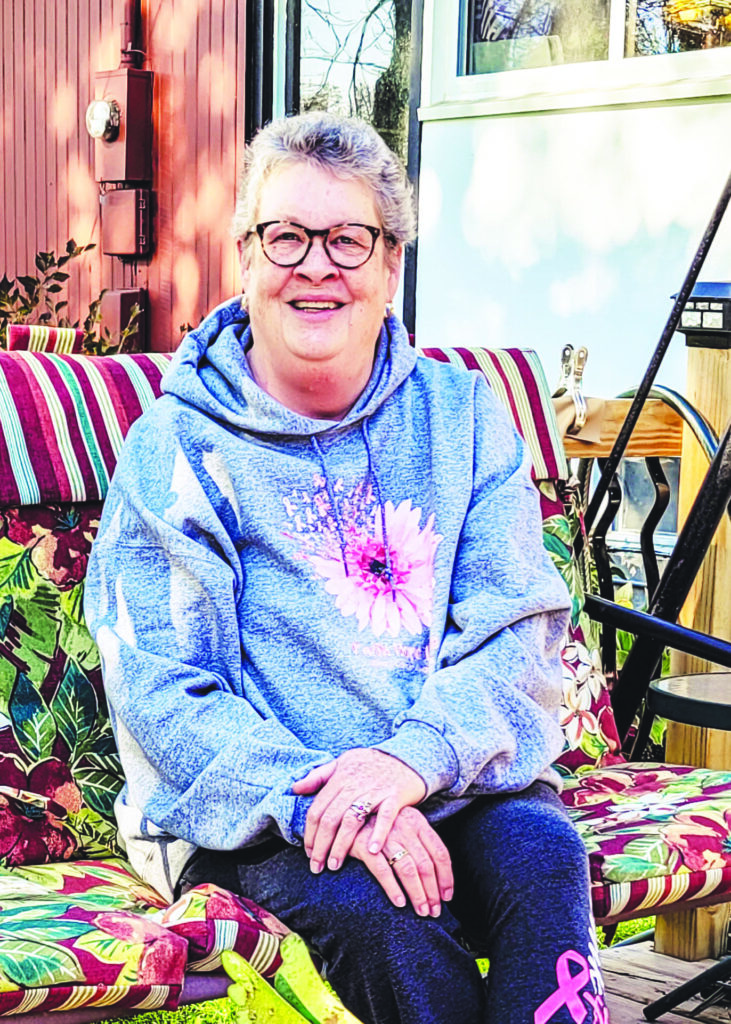
Marti Simmons of Moorhead says her second battle with breast cancer, 20 years after the first, was an entirely different experience, thanks to the women of Roger Maris Cancer Center and integrative medicine. (Photo/Nancy Hanson.)
Nancy Edmonds Hanson
It had been 20 years since Marti Simmons heard the dire diagnosis: “We found a lump.” But now, long after she had been declared cancer-free, she would hear those words echoed again after what started as a routine annual mammogram.
“My world dropped out from under me all over again,” the Moorhead woman recalls of that moment in November 2020. “I’d already taken one for the team 20 years ago. How could this happen now? Why me? What were the odds?”
One in eight American women develops breast cancer at some point during her life. Only a scant number will face the same dragon twice … scarcer still so long after recovery, and vanishingly seldom with a second lump in the same breast. But that’s what changed Marti’s life – again – almost a year ago.
“It was random,” she shrugs. Tests determined thus tumor was entirely unrelated to her first; genetic review failed to find any inborn vulnerability. “It was just the luck of the draw.”
Now once more cancer-free after a full mastectomy and a year of treatment, the retired teacher has a stern assignment for other women who may put off those annual breast exams as risky or optional: “Schedule that mammogram now. Fear of risk or pain is no reason to put it off. You’re safer from Covid in a medical setting than anywhere else on earth.” She adds, “Three minutes of a little pain is nothing compared to the risk of missing a lump. Mine were both so deep I’d never have found them in a self-exam.”
Marti was faithful with those yearly exams. Though most cancer survivors relax after five or 10 years cancer-free, she continued to get annual exams. On Nov. 12, 2020, a radiologist spotted a suspicious dot in her x-ray just above the spot where a lumpectomy had been performed decades before. It was biopsied and, just before Thanksgiving, she got the call. Her medical team – with her husband’s concurrence – recommended a full mastectomy. Though it was very small, they said, the radiation she had received so many years ago ruled out another minimally invasive procedure.
“I thought, ‘Oh, here we go again,’” she remembers.
First time around, Marti was 20 years into a three-decade teaching career in West Fargo. She had worked with gifted and talented students for seven years and then 8th and 9th graders for five; since then, she’d been teaching AP English and coaching speech and debate. With little personal leave, she fit her lumpectomy and subsequent chemo and radiation therapy right into her teaching schedule.
“I didn’t have time for this. I spent every day off getting chemotherapy – NDEA, Veterans Day, Thanksgiving, Christmas,” she says. After the rigorous chemo treatment, she immediately began radiation therapy. On those days, she’d show up at the hospital at 7:30 a.m. with her school clothes in a duffel, put on a gown for treatment, then get dressed and go to school.
“After the treatments were over, they basically said, ‘You’re good to go,’” she remembers. “You were pretty much on your own, except for being cautioned to get regular mammograms.”
Her second experience, she observes, has been very different, thanks to the Maris Cancer Center’s adoption of integrative support. As she went through chemo treatments and, now, immunosuppressive therapy, she has been surrounded by supportive programs that have made recovery a far more positive experience. From mental health services to counseling, art therapy, yoga, mindfulness and a host of services that fall under the banner of integrated care – healing methods that focus on the whole person; body, mind and spirit.
Which is a very good thing, since Marti says the past year has revolved fully around going to Roger Maris. “The pandemic has been somewhat beneficial, in a way,” she muses. “We weren’t supposed to go anywhere, anyway. I didn’t have to turn down invitations or make social plans; everyone was staying home.” The principally female staff of the cancer center became not only care-givers but advisors, teachers and, most of all, friends. “I’ve never felt so nurtured or supported in my life,” she says now. “Those women literally and figuratively saved my life.”
The two-time cancer survivor compares her two experiences with cancer to riding a teeter totter. “When cancer gets on, you go way up in the air and dangle there until it’s over. That’s what it was like the first time around,” she says. “This time, other people got on along with me. They balance me. It’s not just about physical health. My mental and spiritual health have been taken care of. They made it possible for me to look at it all rationally and get through it.”
As she approaches her final immuno treatments in January, lingering effects remain. She has no appetite, she says, and is easily tired or overwhelmed. Too, her knitting is curtailed by numbness in her fingertips, a relic of chemotherapy.
But so much of the news is good. Twenty years ago, she wondered if she’d live long enough to attend her teen children’s weddings. She and husband Ernest, professor emeritus of religion at Concordia, did just when daughter Leah was married last May. They have made time in their lives for travel, a passion they resolved to pursue after her first recovery. And she has come to believe that if you can beat cancer, you can – and should – follow your dreams.
“This experience is still the focus of my life, but there is so much more,” she says. “We have so far still to go.
“After all, I’m getting older. I’m burning time! Let’s get on with it.”


